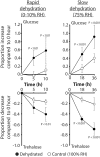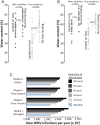Dehydration prompts increased activity and blood feeding by mosquitoes
- PMID: 29717151
- PMCID: PMC5931509
- DOI: 10.1038/s41598-018-24893-z
Dehydration prompts increased activity and blood feeding by mosquitoes
Abstract
Current insights into the mosquito dehydration response rely on studies that examine specific responses but ultimately fail to provide an encompassing view of mosquito biology. Here, we examined underlying changes in the biology of mosquitoes associated with dehydration. Specifically, we show that dehydration increases blood feeding in the northern house mosquito, Culex pipiens, which was the result of both higher activity and a greater tendency to land on a host. Similar observations were noted for Aedes aegypti and Anopheles quadrimaculatus. RNA-seq and metabolome analyses in C. pipiens following dehydration revealed that factors associated with carbohydrate metabolism are altered, specifically the breakdown of trehalose. Suppression of trehalose breakdown in C. pipiens by RNA interference reduced phenotypes associated with lower hydration levels. Lastly, mesocosm studies for C. pipiens confirmed that dehydrated mosquitoes were more likely to host feed under ecologically relevant conditions. Disease modeling indicates dehydration bouts will likely enhance viral transmission. This dehydration-induced increase in blood feeding is therefore likely to occur regularly and intensify during periods when availability of water is low.
Conflict of interest statement
The authors declare no competing interests.
Figures





References
-
- Chown, S., & Nicolson, S. W. Insect Physiology Ecology: Mechanisms and Patterns. (Oxford University Press, 2004).
-
- Dai A. Increasing drought under global warming in observations and models. Nature Clim. Chan. 2013;3:52–58. doi: 10.1038/nclimate1633. - DOI
Publication types
MeSH terms
Substances
Grants and funding
LinkOut - more resources
Full Text Sources
Other Literature Sources

